While many of us wasted our student years drinking to excess, out on the pull, and rushing to meet essay deadlines, Bruno Belamich and Carlos Rosillo were busy hatching a plan to take the watch industry by storm.
Founded in 1992 initially as a university project, Bell & Ross (a play on Belamich and Rosillo) took instrumental pieces from the worlds of aviation, diving and the military and transformed them into functional, stylish wristwatches ready for whatever the wearer desired.
It was an inspired concept. Following the brand’s first Baselworld in 1995, it was one of the talking points of the exhibition from journalists and retailers alike, and by 2002 Chanel Horlogerie had invested in company shares and opened the gates to its watch production site in La Chaux-de-Fonds, Switzerland; from a dorm room to a luxury watch boutique in just a decade.
The key juncture in Bell & Ross’ history was still to come. In 2005, the brand launched the BR 01 Instrument, a watch that would not only lay the foundations for the future of the brand, but become a genuine icon of modern watchmaking. Inspired by antique dashboard instruments found on military aeroplanes, Belamich created a simple yet wholly unique design: a round dial with a square case, punctuated by four screws, one at each corner. The functionality, legibility, and minimalism combined to create something that was quite unlike any other tool watch seen before.
Since then, Bell & Ross has been one of the most actively creative watch brands on the market, reeling off an impressive rota of instrument-inspired novelties. While the square-case-round-dial design remains its signature – including on its best-selling BR 05 sports watch, first released in 2019 – there have been a number of more conventional watches launched in the intervening years, but each is imbued with that typically Bell & Ross sense of stylish functionality.
Chief executive Rosillo has remained at the helm of the company he co-founded 30 years ago. In this interview, he reflects on the brand’s journey, the lessons he’s learnt along the way, and the secret to Bell & Ross’s design.
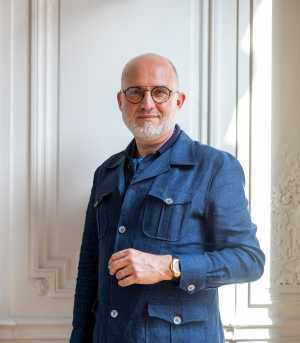
Square Mile: Take me back to your first ever Baselworld in 1995. What was the initial reaction to the brand? Was it a difficult sell?
Carlos Rosillo: I used to call this period of our history the “Far West” even if Basel wasn’t that far or particularly west for us! It was a time when we had this really adventurous spirit – a moment where I would say we had a good combination of our passion for watches and an exhibition that had a lot of curiosity for something new.
We started with a strong collection of watches and they had an immediate impact. It was amazing. Cream rises to the top and I think what we found when we showcased our brand for the first time was that the top retailers, the top journalists, they all reacted in a really positive way. They know what a good watch looks like and when you surprise them with a totally new design and a high quality product, that gets people excited. I suppose the best way of illustrating it is we used to have one of the smallest booths in Baselworld, but it was incredibly busy with people curious about this emerging brand. As a small business, we didn’t know what to expect, but not in our wildest dreams did we envisage such an immediate response and such high demand.
SM: Bell & Ross started as a university project between yourself and Bruno Belamich. Being that close to the concept, you don’t know how people are going to react until you showcase your watches for the first time.
CR: You’re right – you go in with only your passion and you hope that people can see your vision. But we’d been preparing the project for a long time, the initial collection was so good and we were lucky that we had right the combination of expertise within the team, so we went in with confidence.
I think sometimes with these big watch exhibitions you like to be surprised by something that perhaps you didn’t expect. It was the same with Franck Muller and Richard Mille, or with the relaunch of Panerai, all those brands at one stage were newcomers and they brought something different to the watch world – a good product with a strong character at its core. If you have the right product, it can have that immediate impact. People can see the potential.
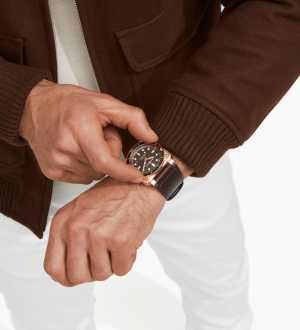
SM: The thing that immediately springs to mind when you think of Bell & Ross is that very distinctive design language. It’s such a clear concept.
CR: I think the terminology you have used is an appropriate one: design language. After all, design is a way of communication and Bruno [Belamich], our creative director, has a strong message that he wishes to convey. The reinterpretation of military watch design history, the influence of Bauhaus, combining form and function, that speaks to a broad audience. But since day one, Bell & Ross watches have been a strong combination of design, engineering, watchmaking and professional use.
For us, it was so important to focus on each of these facets to be a well-rounded watch brand. Early on a journalist compared our watches to those of a Grande Maison – the great houses of watchmaking – and for us that was the highest compliment we could receive.
SM: More than that, you were very ambitious early on, such was your confidence in the design and the engineering aspects. The Hydromax in 1997, for example, you immediately went after the world record for the most water resistant watch.
CR: When we entered into the market we didn’t put up barriers for ourselves in terms of our ambition, but in our position in the market we were confronted by a number of top brands who were already a century ahead in the industry. So we didn’t consider it ambitious, we had to grow quickly, to design and innovate, in order to compete. We were lucky that we had an immediate response to the brand, but the question was how do we handle this success and demand.
Chanel first came on board in 1998. They entered into the company because they know watches and the luxury market, and they were also doing very good things with their own watchmaking. That really helped us to stabilise and to grow, not only financially, but in terms of manufacture, as we accessed Chanel’s watch production site in La Chaux-de-Fonds. They are such a strong asset to have on board – someone who has a long-term view in terms of business and a very good sense of quality. It gives you the appropriate tools to realise your vision.
We had a very good philosophy from the outset. Simple principles in terms of design, readability, functionality, reliability, which gave Bell & Ross a very good starting base from which to develop our brand. Being lucky to be surrounded by good partners was the next stage of that. It means that we’ve been able to face the challenges along the way, things like the pandemic, and come out the other side. When you have a good philosophy, good people, and good partners, it helps a lot.
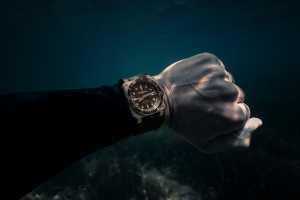
SM: There were countless challenges during the pandemic, but it also presented an opportunity for growth or reassessment for those brands willing to take the risk. After the fact, we now know the brands that were less conservative in their approach have benefitted the most. I think Bell & Ross falls into that category.
CR: I think you’re absolutely right.
The question is how do you create and maintain momentum? In our business – the industrial perspective, the craftsmanship side of the business – if you’re not working two years ahead, you’re just not going to be able to deliver the watches you want. During this pandemic time, we were mindful not to make any sudden moves in terms of industrialisation, not panicking, ensuring that you can continue to produce watches, not going beyond production capacity, means that when you finish the crisis and stores are open again, you have the production line ready to go and you can face the demand. But for that you need to have confidence.
One of the key points about production is that it’s very long term, it’s very driven, it doesn’t react fast, whereas the commercial and business aspect requires immediate action, it requires product now. Being able to balance these two sides of the company is only a question of confidence and financial means.
You can’t change what happens in the outside world; what you can change is how you react to it. That differs according to who you are, your state of mind, the brand that you are, your history, and of course your financial means. For instance, when it comes to creativity, we had to decide whether to put designs on hold for a year or whether to continue to produce new models.
SM: If you were to ask any watch fan what model comes to mind when they think of Bell & Ross, I think many would reach for the BR 01 Instrument. When you have such an iconic design, is it difficult to continue to search for new ideas, or does it provide you with the perfect canvas?
CR: I think having an icon is a blessing. It’s such a strong asset for the brand. Going from this icon, there are many roads. Bruno has the skill to be very creative and to continue to develop this concept in new ways, like recent instruments the Multimeter, the Radar, the HUD. Then you have the possibility to do something different like the BRV1 Bellytanker, which is a different casing, different shape, probably more comparable to other watches on the market, but because of Bruno’s style it still is typically Bell & Ross.
One of the very interesting moves that we were able to achieve three years ago is the BR 05, our sports watch. You can see that it’s still inspired by the instrument line – it has the same round dial with the square case shape, with four screws – but making it softer, more elegant, more urban.
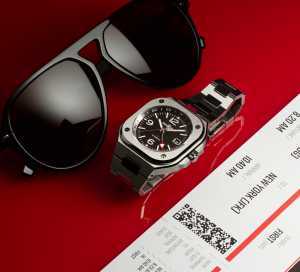
The character of the BR 05 is an evolution of the BR 03 to be easier to wear on the day to day. It’s a seamless evolution, but one that has created a second icon. This is very exciting for us. Both are instantly recognisable, while one is slightly more niche in its use. In motoring terms, it’s a bit like Land Rover going from the Defender to the Evoque – going from the countryside, the field, to something that is much more at home in the city.
I think, whatever the model, you can immediately see the Bell & Ross style because it’s so consistent, but we are now moving out of the niche. With the BR 05 especially, I’d say it has a much broader audience than the BR 01 and the BR 03.
In the last three years the BR 05 has already proven itself to be a second pillar for Bell & Ross – in fact in some countries it has already overtaken our other models as the bestseller.
SM: Moving from a tool watch to a sports watch is a very seamless path, but it’s fascinating to hear how strong the sports watch continues to resonate in the market.
CR: Our idea was very simple. The BR 01 or the BR 03, you can’t wear it with a metal bracelet, because neither were originally designed to have one. They’re great watches on a rubber or leather strap, but they don’t carry quite the same jewellery aspect. Bruno wanted to have an iconic design with an integrated bracelet, so that was our starting point with the BR 05.
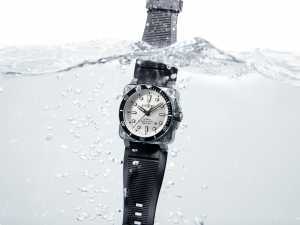
I remember three years ago when we launched the BR05, the trend wasn’t quite so popular. Now? Every brand is doing a metal bracelet, whether it’s Hublot or Laurent Ferrier. Of course, one of the great masters of the integrated bracelets was Gerald Genta, and we all know his influence. But it’s interesting to see the trend come full circle back to the 1970s and 1980s.
SM: What are you excited about from this year’s novelties?
CR: I think we’ve been quite creative this year with the launch of the BR 03 Multimeter, as well as the BR 05 Chrono Edición Limitada inspired by the world of cigars, but we have another big surprise coming at the end of the year. The focus is on the technical field and on the manufacture aspect of watchmaking, but that’s all I can say for now.
Creativity is so important in our business: to create that sense of surprise but also to maintain momentum. The challenge is knowing how to innovate while remaining consistent. I think that this is the big challenge, because if you don’t remain consistent, you’re not reinforcing your brand awareness.

SM: You’ve been running Bell & Ross for 30 years now. What’s been your biggest lesson?
CR: What I have learned is not to compromise on the principles of the company, to not lose sight of your initial passion and dreams. Also, I’d say keep things simple – don’t make the business too complicated. Surround yourself with loyal partners, a good team and good people.
Good partners gives you that long-term view and confidence, but a good team means that every day is enjoyable. In that sense, business is really quite similar to personal life: the more good people you have around you, the better life is. It’s as simple as that.
See more at bellross.com
